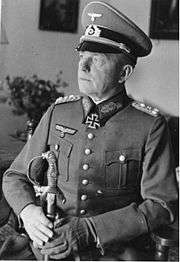Paul Ludwig Ewald von Kleist
| Ewald von Kleist | |
|---|---|
 Kleist in 1940 | |
| Born |
8 August 1881 Braunfels, German Empire |
| Died |
13 November 1954 (aged 73) Vladimir Central Prison, Soviet Union |
| Allegiance |
|
| Service/ | Army (Wehrmacht) |
| Rank | Generalfeldmarschall |
| Commands held |
1st Panzer Group Army Group A |
| Battles/wars | |
| Awards | Knight's Cross of the Iron Cross with Oak Leaves and Swords |
Paul Ludwig Ewald von Kleist (8 August 1881 – 13 November 1954) was a German field marshal during World War II. He commanded the 1st Panzer Group during Operation Barbarossa in 1941 and Army Group A during the Wehrmacht's 1942 summer campaign. Following the war, Kleist was extradited to the Soviet Union and was convicted of war crimes; he died in prison.
World War II
Kleist, who had retired in 1935, was recalled to active duty in August 1939. He commanded the XX Panzer Corps during the invasion of Poland. In 1940, he commanded the Panzergruppe von Kleist (XIX and XLI Panzer Corps, XIV Corps) which spearheaded the German breakthrough in the Ardennes sector.
In April 1941, Kleist commanded the 1st Panzer Group, comprising III, XIV and XLVIII Panzer Corps and XXIX Infantry Corps, which spearheaded the invasions of Yugoslavia and Greece. With this formation he also participated in the subsequent Operation Barbarossa as part of Army Group South.
In 1942, Kleist was sent to command troops in the Caucasus in order to capture important oil wells in the area. On 22 November 1942, he was placed in command of Army Group A. He was promoted to Field Marshal in 1943. He was relieved of his command in March 1944 for ordering the 8th Army to fall back without Hitler's approval. Kleist was taken prisoner by U.S. forces in 1945, and was sent to Yugoslavia to face war crimes charges in 1946. In 1948 he was extradited to the Soviet Union where he was given a 10-year sentence in 1952 for war crimes. He died in the Vladimir Central Prison in 1954, the highest ranked German officer to die in Soviet captivity.[1]
Awards
- Iron Cross (1914) 2nd Class (4 October 1914) & 1st Class (27 January 1915)[2]
- Clasp to the Iron Cross (1939) & 2nd Class (17 September 1939) & 1st Class (27 September 1939)[2]
- Knight's Cross of the Iron Cross with Oak Leaves and Swords
- Knight's Cross on 15 May 1940 as General der Kavallerie and commanding general of XXII. Armeekorps (Panzergruppe "von Kleist")[3]
- Oak Leaves on 17 February 1942 as Generaloberst and Commander-in-chief of Panzergruppe 1[3]
- Swords on 30 March 1944 as Generalfeldmarschall and Commander-in-chief Heeresgruppe A[3]
References
Citations
Bibliography
- Leon Goldensohn: Die Nürnberger Interviews. Gespräche mit Angeklagten und Zeugen. (Original: The Nuremberg Interviews. New York, 2004). Herausgegeben und eingeleitet von Robert Gellately. Artemis und Winkler, Düsseldorf / Zürich 2005, ISBN 3-538-07217-5.
- Parrish, Michael (1996). The Lesser Terror: Soviet State Security, 1939–1953. Praeger Press. ISBN 978-0-275-95113-9.
- Scherzer, Veit (2007). Die Ritterkreuzträger 1939–1945 [The Knight's Cross Bearers 1939–1945] (in German). Jena, Germany: Scherzers Militaer-Verlag. ISBN 978-3-938845-17-2.
- Thomas, Franz (1997). Die Eichenlaubträger 1939–1945 Band 1: A–K [The Oak Leaves Bearers 1939–1945 Volume 1: A–K] (in German). Osnabrück, Germany: Biblio-Verlag. ISBN 978-3-7648-2299-6.